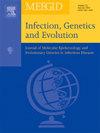Europe-wide distribution and bat-host specific lineages in the malarial parasite Polychromophilus murinus revealed through genetic screening of bat flies
IF 2.6
4区 医学
Q3 INFECTIOUS DISEASES
引用次数: 0
Abstract
Malaria parasites of the genus Polychromophilus commonly infect vespertilionid and miniopterid bats, and are transmitted by bat flies (Nycteribiidae). While Polychromophilus murinus has been recorded sporadically in Europe, its host range, distribution and phylogeographic structure have not been explored. Here we investigate the prevalence and genetic diversity of P. murinus infections in 1131 bat flies collected from seven European bat species, focusing on Basilia nana, collected from its primary host, the Bechstein's bat throughout its distribution. Additionally, we explore the temporal dynamics of P. murinus in two regions in Germany where bat flies were repeatedly collected over at least five years. Bat flies were screened for Polychromophilus infection via PCR of a fragment of cytochrome b, and fragments of three additional genes were sequenced for positive samples. Overall, P. murinus infections were detected in 287 of 1131 screened bat flies of four different species, collected from seven bat species, across 13 countries. The 269 recovered cytb sequences represented 21 distinct haplotypes, clustered based on the bat species from which the infected flies were collected. Repeated sampling over multiple years revealed a consistent presence of P. murinus in both investigated populations, without substantial variation in prevalence between years. The results suggest an endemic long-term presence of Polychromophilus within European bat populations, and the presence of host-specific associations between P. murinus lineages and its various bat hosts. We posit that exposure to P. murinus appears to be a near certainty in several European bat species, and its potential costs should be further investigated.
通过对蝙蝠蝇的遗传筛选揭示了疟原虫鼠多色嗜菌在欧洲范围内的分布和蝙蝠宿主特异性谱系。
多色疟原虫属的疟疾寄生虫通常感染蝙蝠和小翅目蝙蝠,并通过蝙蝠蝇(夜蛾科)传播。虽然在欧洲有零星的记录,但其寄主范围、分布和系统地理结构尚未被探索。本文研究了从欧洲7种蝙蝠中采集的1131只蝙蝠蝇感染P. murinus的流行率和遗传多样性,重点研究了从其主要宿主贝希斯坦蝙蝠中采集的巴西蝇。此外,我们探索了P. murinus在德国的两个地区的时间动态,在那里蝙蝠蝇被反复收集了至少五年。通过细胞色素b片段的PCR筛选蝙蝠蝇感染多色嗜杆菌,并对阳性样本的另外三个基因片段进行测序。总体而言,从13个国家的7种蝙蝠中采集的4种不同种类的1131只蝙蝠蝇中,有287只检测到P. murinus感染。269个恢复的cytb序列代表21个不同的单倍型,根据收集到感染蝇的蝙蝠物种聚类。多年的重复采样显示,在两种调查人群中都一致存在P. murinus,各年之间的流行率没有实质性变化。结果表明,在欧洲蝙蝠种群中,嗜多色菌长期存在地方性,并且在P. murinus谱系与其各种蝙蝠宿主之间存在宿主特异性关联。我们假设,暴露于P. murinus在几个欧洲蝙蝠物种中似乎是几乎确定的,其潜在成本应该进一步调查。
本文章由计算机程序翻译,如有差异,请以英文原文为准。
求助全文
约1分钟内获得全文
求助全文
来源期刊

Infection Genetics and Evolution
医学-传染病学
CiteScore
8.40
自引率
0.00%
发文量
215
审稿时长
82 days
期刊介绍:
(aka Journal of Molecular Epidemiology and Evolutionary Genetics of Infectious Diseases -- MEEGID)
Infectious diseases constitute one of the main challenges to medical science in the coming century. The impressive development of molecular megatechnologies and of bioinformatics have greatly increased our knowledge of the evolution, transmission and pathogenicity of infectious diseases. Research has shown that host susceptibility to many infectious diseases has a genetic basis. Furthermore, much is now known on the molecular epidemiology, evolution and virulence of pathogenic agents, as well as their resistance to drugs, vaccines, and antibiotics. Equally, research on the genetics of disease vectors has greatly improved our understanding of their systematics, has increased our capacity to identify target populations for control or intervention, and has provided detailed information on the mechanisms of insecticide resistance.
However, the genetics and evolutionary biology of hosts, pathogens and vectors have tended to develop as three separate fields of research. This artificial compartmentalisation is of concern due to our growing appreciation of the strong co-evolutionary interactions among hosts, pathogens and vectors.
Infection, Genetics and Evolution and its companion congress [MEEGID](http://www.meegidconference.com/) (for Molecular Epidemiology and Evolutionary Genetics of Infectious Diseases) are the main forum acting for the cross-fertilization between evolutionary science and biomedical research on infectious diseases.
Infection, Genetics and Evolution is the only journal that welcomes articles dealing with the genetics and evolutionary biology of hosts, pathogens and vectors, and coevolution processes among them in relation to infection and disease manifestation. All infectious models enter the scope of the journal, including pathogens of humans, animals and plants, either parasites, fungi, bacteria, viruses or prions. The journal welcomes articles dealing with genetics, population genetics, genomics, postgenomics, gene expression, evolutionary biology, population dynamics, mathematical modeling and bioinformatics. We also provide many author benefits, such as free PDFs, a liberal copyright policy, special discounts on Elsevier publications and much more. Please click here for more information on our author services .
 求助内容:
求助内容: 应助结果提醒方式:
应助结果提醒方式:


